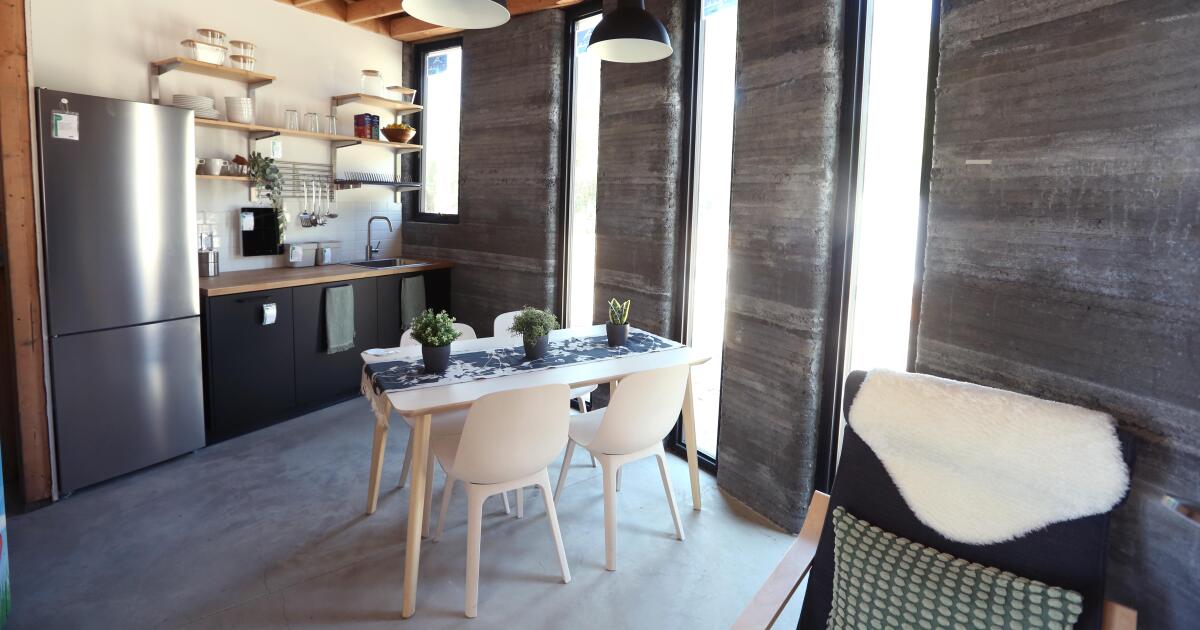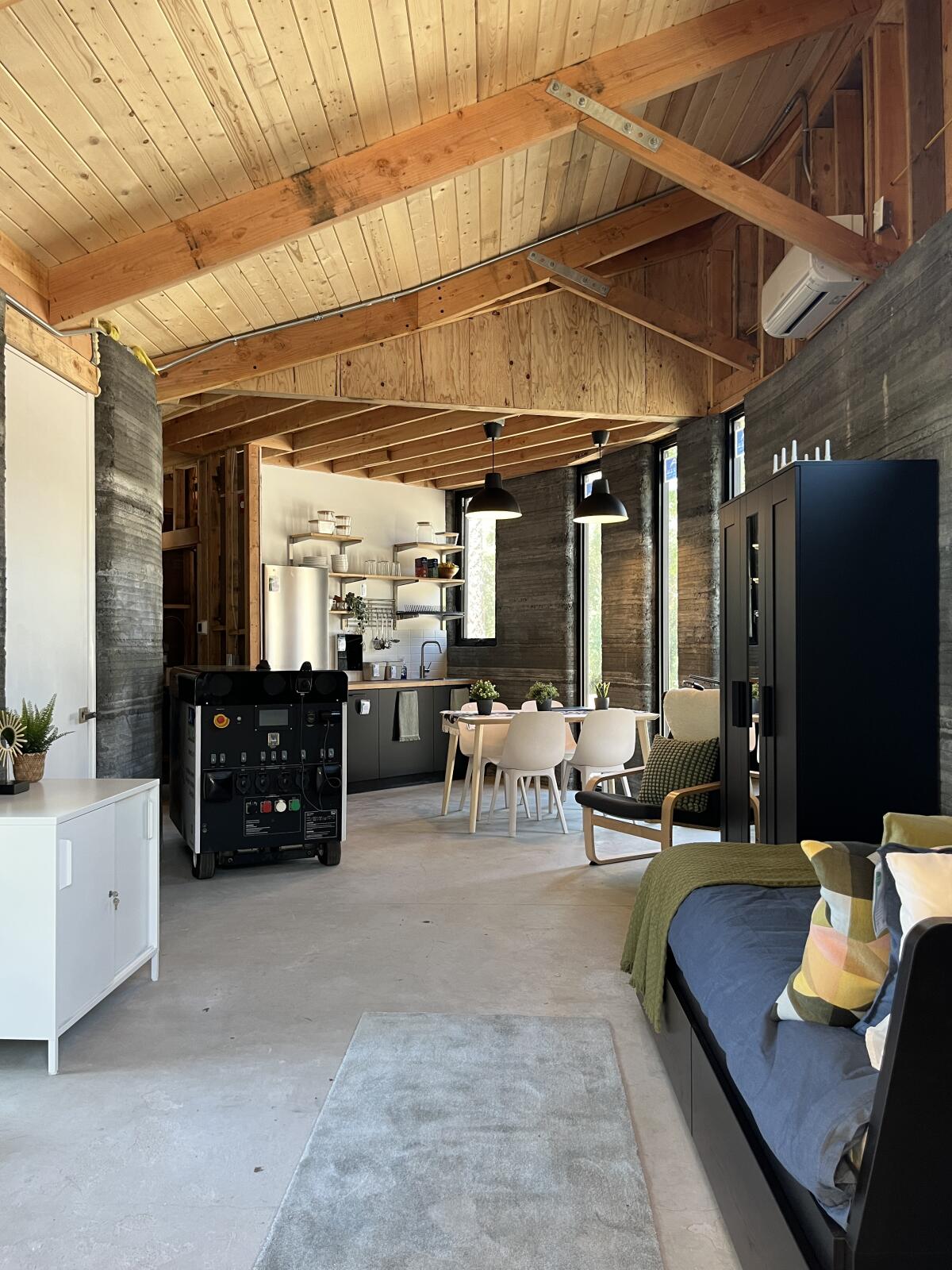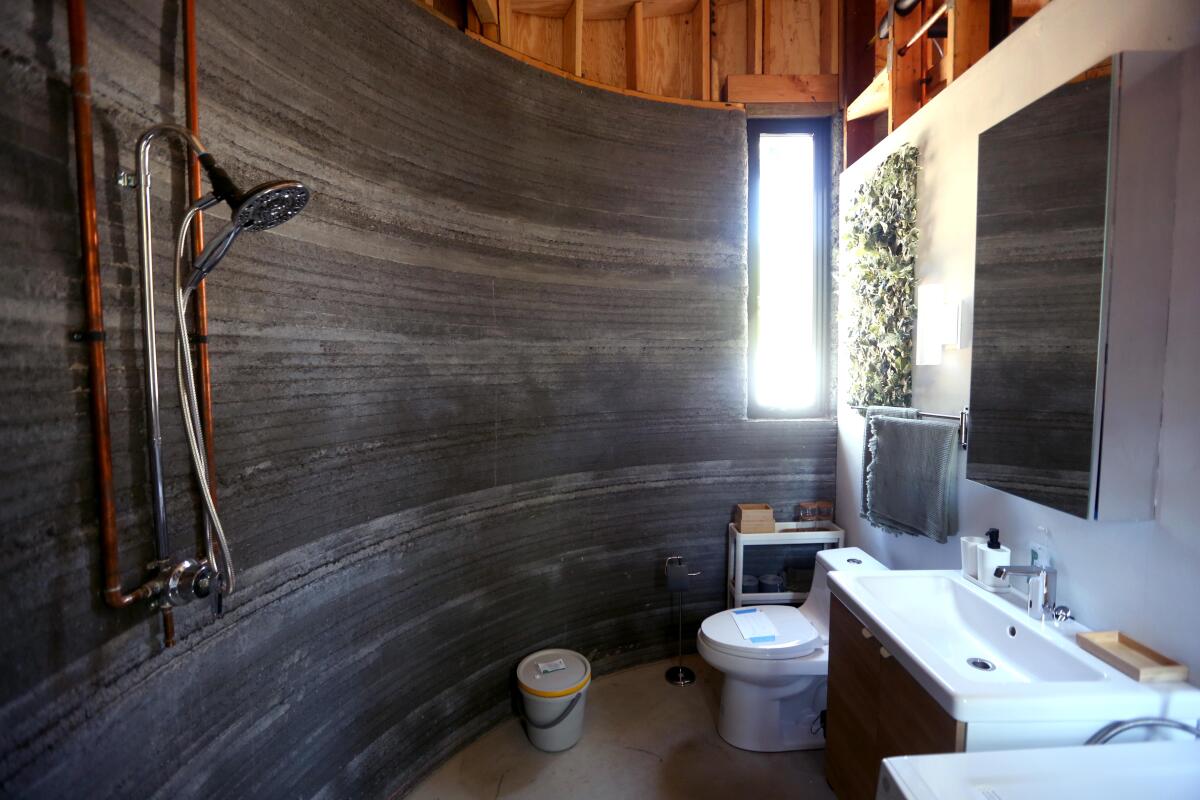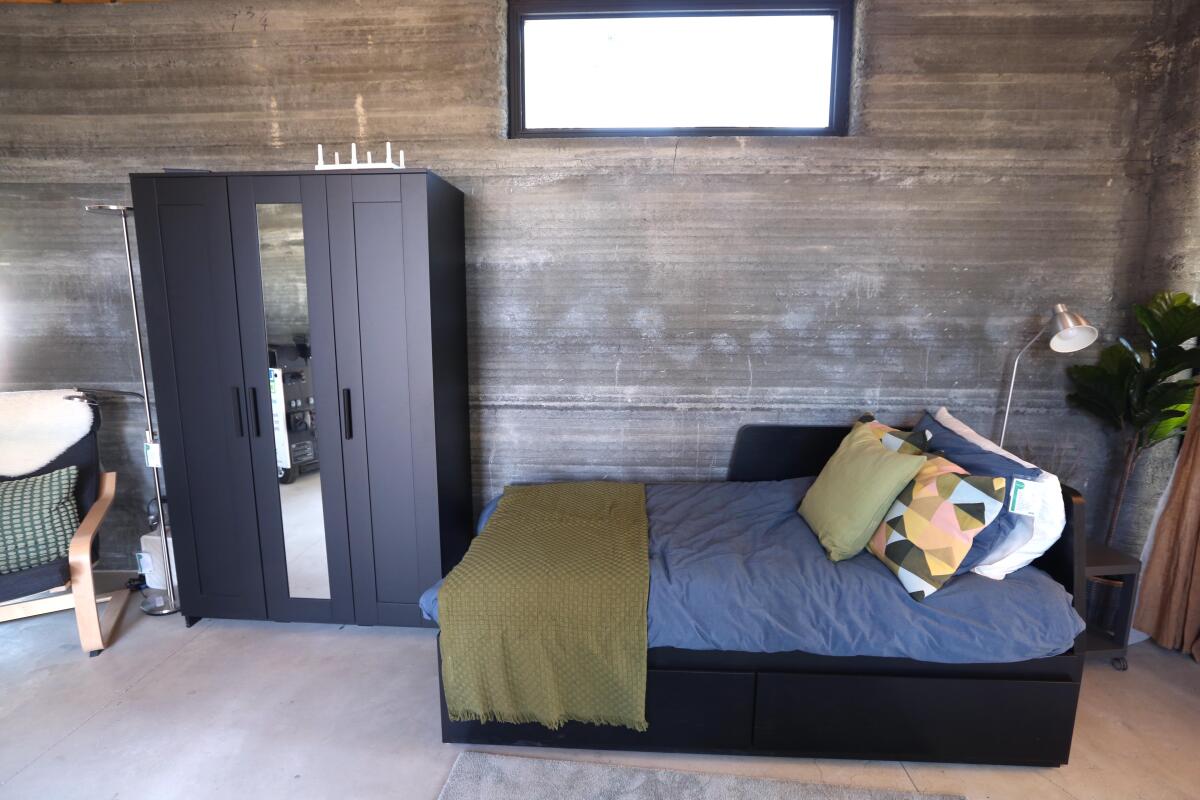
3-D printed house in LA addresses climate and housing crises
Tucked alongside a large dorm building on the fringes of Woodbury University’s campus in Burbank is a small but very eye-catching house. The 425-square-foot home is contained by a gently curving concrete form equipped with a generous porch and a dramatic sloping roof. Slender, carefully staggered floor-to-ceiling windows gently illuminate the interior.
It’s a nice piece of architecture. What makes it truly remarkable is who built it — and how.
The Solar Futures House, as it is formally known, was designed by Woodbury architecture students and constructed out of concrete using the latest 3-D printing technology. It is the first such permitted structure in the city of Los Angeles, according to Woodbury architecture dean Heather Flood. And it was built by Emergent, a 3-D printing construction firm based in Redding. (A quick geography explainer: While Woodbury has a Burbank address, a piece of the campus, where the house was built, is located within Los Angeles city limits — hence the L.A. permits.)
Most notable is how quickly this project came to fruition. “It was 15 months from design, going through the permitting process with the city, working with the printing company and dealing with 14 atmospheric storms,” says Kishani De Silva, chair of the construction management program at Woodbury, who served as faculty lead on the project. “It came to life on the 12th of May. … The next day the students literally graduated.”
From design to near completion in 15 months? In bureaucratic Los Angeles, that counts as damn near miraculous.
Woodbury student Sergio Santos, second from right, joins Woodbury faculty and administrators Kishani De Silva, left, Heather Flood and Aaron Gensler in front of the Solar Futures House.
(Genaro Molina / Los Angeles Times)
Certainly, it helped that students were collaborating with municipal experts from the Mayor’s Office of Energy and Sustainability, the Bureau of Engineering and a nonprofit clean tech incubator at the Department of Water and Power — organizations that could help navigate the red tape. But at a time when our region is gripped by a housing and homelessness crisis, it is nonetheless a model worth examining.
To be clear, the house is not 100% complete — though it’s awfully close. A couple of the interior areas are still in need of drywall, and some exterior features and the landscaping remain unfinished. Moreover, the building will require a certificate of occupancy from L.A.’s Department of Building and Safety.
But it is an impressive piece of design, achieving a lot in a small space.
The layers of 3-D-printed concrete give the walls a geologic look, and the curving shape and high ceilings prevent this intimately scaled studio from feeling like a shoebox. In addition, the covered porch and the living room are connected by a sliding door; throw it open and the space feels bigger and airier.

A combined living/sleeping area in the foreground leads to an open kitchen/dining space in the Solar Futures House at Woodbury University.
(Carolina A. Miranda / Los Angeles Times)
And, true to its name, this is a structure that prioritizes environmental concerns.
The Solar Futures House began as an entry in the Solar Decathlon, a national collegiate competition organized by the U.S. Department of Energy that encourages budding designers to create high-performance structures powered by renewable energy.
In the spring of 2022, a class of Woodbury students submitted a design proposal and was selected as one of 14 finalists, receiving a $50,000 grant for construction. By the fall of that year, the team was breaking ground.
The structure they proceeded to build was all about efficiency. Shower water is recirculated for toilet flushing. The home’s bending form and sloped roof are designed to respond to the angle of the sun over the course of the year, thereby maximizing the generation of solar power. Currently, the structure features one solar array on the roof, which makes the building net zero (meaning no additional electricity is needed to power the home). Add another and it becomes net-positive, supplying energy to the grid.
The angled roof is made out of a reflective, resin-coated metal and sits atop 9 inches of mineral wool insulation, which helps preserve the building’s interior temperatures and buffer external noise. (Woodbury’s campus sits next to the 5 freeway, but between the double-layer concrete walls, the triple-glazed windows and the insulation, the house feels peaceful.) Mineral wool insulation also functions as a fire barrier — addressing another environmental concern in California.
To mitigate the use of concrete, which is carbon-intensive, the team developed a formula that contained a higher percentage of fly ash, making it more sustainable. The precise nature of 3-D printing also means that no concrete goes to waste.
This new construction method allowed for the speedy erection of the building’s double-layer walls: De Silva estimates that printing took about three days. It also let students play with form. In a traditional stick-build structure, 90-degree angles are the most efficient way for walls to meet. But 3-D printing allows for more flexible shapes; hence the curving walls, which give the house a more organic feel. Take the bathroom: Designed to be compliant with the Americans With Disabilities Act, it is no afterthought — it’s tucked into an attractive rounded room that also includes laundry facilities.

A bathroom with a curving wall in the Solar Futures House is attractive, space-efficient — and it meets ADA standards.
(Genaro Molina / Los Angeles Times)
Naturally, the DOE’s grant didn’t cover all of the costs.
Flood estimates that the budget for the house currently stands at about $250,000, including in-kind support and donated services from area firms. L.A.-based Nous Engineering pitched in on the structural work, while Breen Design Group in Torrance helped with the mechanical systems; Mitsubishi Electric donated an HVAC system and Ikea supplied furnishings.
The Solar Futures House is a significant achievement — especially considering that Woodbury is a small school (with fewer than 1,000 undergraduates) and its accredited architecture program is relatively new, established in 1994. The university serves students primarily from Southern California, many of them Latino, making it a designated Hispanic-Serving Institution. (The school plays a critical role in diversifying the field, since architecture remains overwhelmingly white.)
Two dozen students worked on the Solar Futures House over a period of two academic years, rotating in and out of the project as part of their coursework. But a number of them were able to see it through from beginning to end, including Karin Najarian and Jade Royer; Sergio Santos was able to work on the home throughout the entire final year.

A day bed in the Solar Futures House could serve multiple functions.
(Genaro Molina / Los Angeles Times)
The Solar Futures House soon will be habitable; university administrators are debating how it might be used. Possibilities include a guest house for visiting speakers or a residence for a housing-insecure student.
Whatever its ultimate purpose, the home will continue to function as a teaching tool. “It’s a prototype for a method of design and construction and the actual shape and form could be varied,” says Flood. “It could conform to many different site conditions. You can nest multiple units together in a way that would take advantage of structural efficiencies.” (Construction companies already have begun to create two-story structures using 3-D printing technology.)
Woodbury students will be able to take this initial concept and run with it, refining and adapting it to suit the needs of other constituencies, such as the elderly.
The house may be almost complete, but the ideas that informed it are just beginning to take off.

To learn more about the Solar Futures House, and keep up on any upcoming public events, check the project’s website at solar.woodbury.edu.